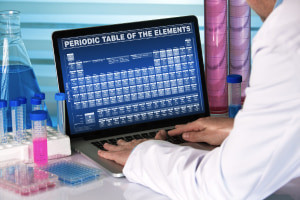Dmitri Mendeleev arranged elements by atomic mass (the sum of protons and neutrons) and the modern Periodic Table orders them by atomic number (the number of protons or electrons in a neutral atom). We begin by identifying the eighteen ‘groups’ (vertical columns) and seven ‘periods’ (horizontal rows) found in today's Periodic Table. We study four (‘s’, ‘p’, ‘d’ and ‘f’) block elements, their location in the Periodic Table and their subshells filling. We then examine the placement of metals, metalloids and non-metals and their properties.
The course then delves into the periodicity of physical properties, beginning with atomic radii. We then explain how melting points and conductivity across periods are affected by the type of element and formed bonds. For example, metals have high melting points because they form powerful metallic bonds while non-metals have lower melting points because they make up simple molecules. Our next topic describes how a higher electronegativity in period 3 increases the first ionisation energy of non-metals relative to metals.
We trace the effect of changes in valence electrons on various chemical properties across the Periodic Table. We outline how period 3 elements like sodium, magnesium and sulphur react with hydrogen and produce golden yellow, bright and blue flames while forming oxides. We demonstrate how quickly or slowly metals, non-metals and metalloids react with chlorine to form chlorides. Finally, we explain how some period 3 chlorides, such as sodium and magnesium, dissociate in water into ions while others, like silicon and phosphorus, hydrolyse and emit white fumes. This course has no prerequisites and is designed for anyone who wants to improve their chemistry skills. Sign up to explore the building blocks of matter and learn how to arrange elements on the Periodic Table.
What You Will Learn In This Free Course
View All Learning Outcomes View Less All Alison courses are free to enrol, study, and complete. To successfully complete this Certificate course and become an Alison Graduate, you need to achieve 80% or higher in each course assessment.
Once you have completed this Certificate course, you have the option to acquire an official Certificate, which is a great way to share your achievement with the world.
Your Alison certificate is:
- Ideal for sharing with potential employers.
- Great for your CV, professional social media profiles, and job applications.
- An indication of your commitment to continuously learn, upskill, and achieve high results.
- An incentive for you to continue empowering yourself through lifelong learning.
Alison offers 2 types of Certificate for completed Certificate courses:
- Digital Certificate: a downloadable Certificate in PDF format immediately available to you when you complete your purchase.
- Physical Certificate: a physical version of your officially branded and security-marked Certificate
All Certificate are available to purchase through the Alison Shop. For more information on purchasing Alison Certificate, please visit our FAQs. If you decide not to purchase your Alison Certificate, you can still demonstrate your achievement by sharing your Learner Record or Learner Achievement Verification, both of which are accessible from your Account Settings.











 Avg. Hours
Avg. Hours  Contains Video
Contains Video  CPD Accredited
CPD Accredited 
 Total XP:
Total XP: 
 Knowledge & Skills You Will Learn
Knowledge & Skills You Will Learn 







